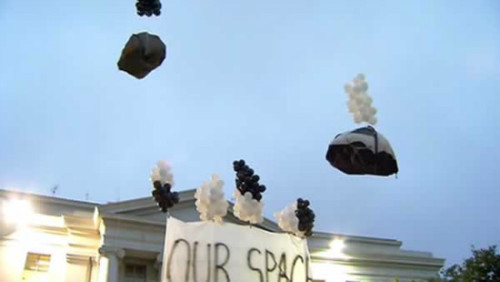A guest post by ARC Associate Director Michele Rabkin.
Someone sent me an email recently asking “where are the artists” in the Occupy Cal movement. My short answer would be: everywhere. From my perch on the sidelines, I have observed arts embedded in the protests and demonstrations in a number of ways and on a number of levels. Some echo long-standing traditions of protest. Folk singers and gospel choirs have sung from the steps of Sproul Hall. Slogans have been hand-lettered on fabric banners that adorn the plaza. Following a joint march of students from UCB and Berkeley High, I’m told that hundreds stood in line to receive silk-screened “Hella Occupy” posters. Others take a more playful/conceptual approach. When tents were banned from the plaza, a group attached tents to balloons and set them afloat in the sky overhead. Others placed dozens of books on the ground, splayed open in tent-like shapes. The plaza sported several installations concocted of tree branches and one large pink paper-mache dinosaur (sadly destroyed in the police raid). There have been satiric performances by the UC Movement for Efficient Privatization (UCMeP).
And then there are artists as citizens. Faculty member and poet Robert Hass has written eloquently about his experience on the front lines of the protests, where he was on the receiving end of a police baton. I count nine ARC-affiliated professors among the group of forty-seven that called for a special meeting of the Academic Senate to discuss recent police actions, and recognize many other familiar names. Even before the recent turbulence, ARC faculty were working to imagine a new future for the university—and in recent days, many of them have been speaking out, teaching-in, and organizing. Artists can bring to the table not just superior graphic design skills or soaring soprano voices, but the ability to think critically, creatively, and expansively. Too often, artists are lauded only for their ability to clearly communicate information or ideas formulated by others. The current moment is one in which we can recognize the role that artists play as thought leaders.
